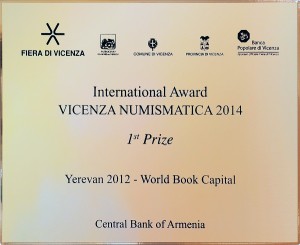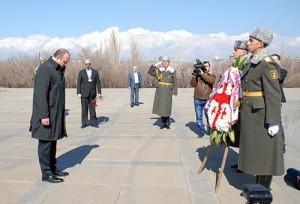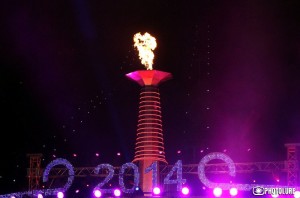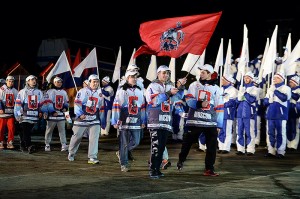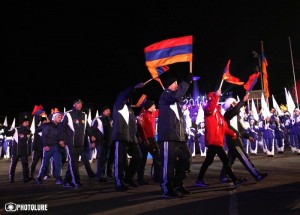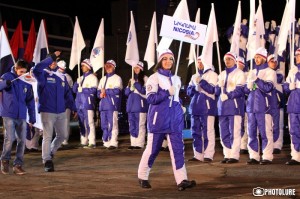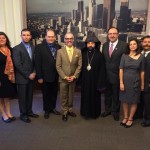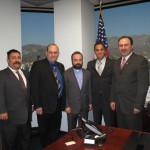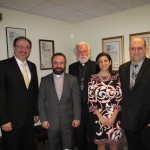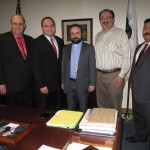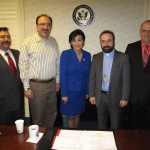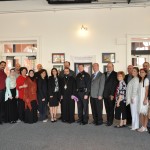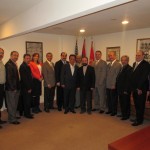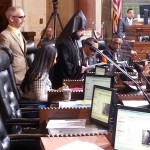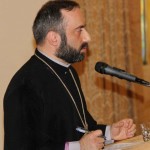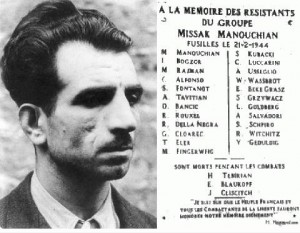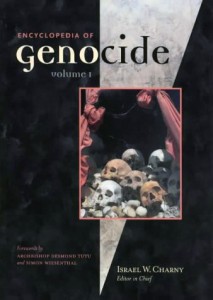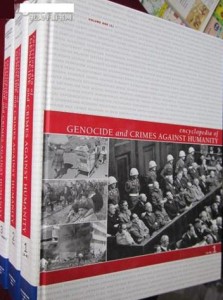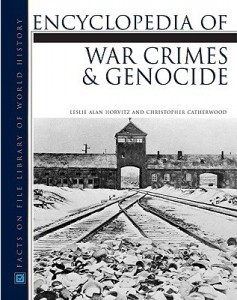Major Exhibit Issued by ANI, AGMA, and Assembly Available Online
WASHINGTON, DC – The Armenian National Institute (ANI), Armenian Genocide Museum of America (AGMA) and Armenian Assembly of America (Assembly) jointly, and in cooperation with the Mother See of Holy Etchmiadzin, the Armenian Genocide Museum-Institute in Yerevan, and the Republic of Armenia National Archives, announced the release of a major exhibit consisting of 20 panels with over 150 historic photographs documenting the role of the Armenian Church during the Armenian Genocide.
Titled ‘The First Refuge and the Last Defense: The Armenian Church, Etchmiadzin, and The Armenian Genocide,’ the exhibit explains the importance of the Mother See of Holy Etchmiadzin during the Armenian Genocide. It also examines the vital leadership role played by the clergy during the Armenian Genocide, especially the all-important intervention of His Holiness Catholicos Gevorg V Sureniants in alerting world leaders about the massacres, effectively issuing the first ‘early warning’ of an impending genocide.
The sacrifices of the Armenian clergy are well documented. Thousands, among them several primates in Western Armenia and other parts of the Ottoman Empire, paid the price of martyrdom for their faith during the Armenian Genocide. Far less well known is the extent to which the Armenian Church in Eastern Armenia, then under Russian rule, came to the assistance of the Armenian people in its hour of plight.
The exhibit provides ample evidence of the aid extended by fellow Armenians to the refugees fleeing Ottoman Turkey as the Young Turk regime pursued its path toward the destruction of the Armenians. It is now almost forgotten that the first people to come to the aid of the fleeing and starving were Armenians across the Russian-Turkish border who welcomed their countrymen into their homes and threw open the doors to their schools, hospitals, and other facilities to house, care, and feed the hungry, the sick, and the homeless.
At the epicenter of this outpouring of aid was Etchmiadzin, the primary destination of the Armenians fleeing the massacres along the border regions of the Ottoman Empire, especially as a result of the great exodus of the Armenian population of Van. They had dared resist extermination only to find themselves abandoning their homeland, when the Russian forces that arrived to deliver them shortly thereafter retreated. After the slaughter of 55,000 Armenians in Van province alone in April 1915, the survivors, 100,000 in all, concentrated in the city of Van, were left with no choice other than exile. As armed Turkish and Kurdish bands pursued them every mile of their trek across the rugged landscape of mountains, valleys, and rivers cutting through gorges, the exodus turned into the road of massacres.
With testimony from survivors and witnesses, the exhibit reconstructs this particular chapter of the Armenian Genocide, a chapter often overlooked in the context of the mass deportations of the Armenians from all across Ottoman Turkey to the interior of the Syrian desert where hundreds of thousands perished from hunger, thirst, and slaughter. The episode in Van was no less tragic as the death toll was no less ferocious even after thousands seemingly reached safety only to die of exhaustion, fright, starvation, and raging epidemics as the resources in Eastern Armenia were quickly overwhelmed and Etchmiadzin transformed overnight into a vast and fetid refugee camp.
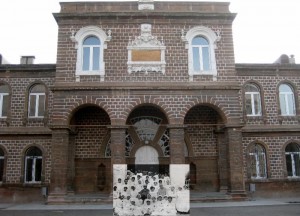 Hovhannes Tumanian with medical volunteers photographed at the entrance to the Gevorgian Academy at Etchmiadzin
Hovhannes Tumanian with medical volunteers photographed at the entrance to the Gevorgian Academy at Etchmiadzin
With 3 maps, 12 historic documents and news clippings, and 16 survivor testimonies, specific to the details of the events documented with over 150 photographs, the exhibit reconstructs the Armenian Genocide in a single region of historic Armenia and reveals how the people of Eastern Armenia became aware of the policies of the Young Turks during World War I. The exhibit combines images retrieved from archives and repositories in Armenia and America and connects them together in this first extensive narrative exhibit on the Armenian Genocide.
These dramatic pictures highlight the role of the Mother See of Holy Etchmiadzin during the critical years of 1915 and 1916. They also explain the invaluable national role of Armenian church leaders as exemplified by four of its outstanding catholicoses, namely Mkrtich I Khrimian, Gevorg V Sureniants, Khoren I Muratbekian, and Garegin I Hovsepiants, the first three, Catholicos of All Armenians and the fourth, Catholicos of the Great House of Cilicia.
The exhibit also explores the role of the laity in responding to the appeals of the Armenian Church and reveals how the Eastern Armenian intelligentsia, as represented by figures such as Hovhannes Tumanian, the most prominent writer of his era, and the famed artist Martiros Sarian, closely cooperated with the Mother See in order to assist the Western Armenian refugees.
Numerous other important figures are also represented through photographs and testimony in the exhibit, including United States President Woodrow Wilson, U.S. Secretary of State William Jennings Bryan, American missionary in Van Dr. Clarence D. Ussher, Prince Argoudinsky-Dolgoroukov, Komitas, Alexander Khatisian, Aghassi Khanjian, and General Andranik Ozanian.
The central role of Near East Relief, the American philanthropic organization constituted in response to the spreading news of the desperate state of the Armenians during World War I, is a subject that has been widely explored due to the availability of extensive documentation and testimony. In comparison, because of the subsequent disasters that struck Eastern Armenia, the role of local Armenian philanthropic organizations operating in the Russian Caucasus that hastened to relieve the plight of the Armenian refugees has been overlooked by historians.
A variety of benevolent groups, local Red Cross committees, and, in particular, the Fraternal Aid Committee, authorized by the Catholicos Gevorg V Sureniants, led the initial responses to the Armenian Genocide. Months before any relief was delivered from overseas, fellow Armenians, medics, nurses, clergymen, and countless volunteers hastened to Etchmiadzin and nearby towns to assist the refugees. This heroic response within a matter of days to the crushing reality of tens of thousands of Armenians made homeless remains a much neglected episode in Armenian history deserving of greater attention. Certainly the photographic evidence gathered in this exhibit attests to the scale of the response and dedication of the Armenian volunteer aid organizations. They were the Transcaucasian counterpart to the Armenian General Benevolent Union operating out of Egypt at the time that reached out to fellow Armenians wherever it could deliver assistance in the Middle East.
The mass of evidence that was gathered for the exhibit required careful examination in order to establish the context of the photographs from that era. The effort to reconstruct this history relied upon historic sites well documented with imagery. For the purpose of this exhibit these primary markers were the famous monastery and school of Varag near Van, where Khrimian Hayrik once presided as abbot; the American missionary station in Van, where Dr. Ussher and his family ministered to the educational, spiritual, and medical needs of Armenians and others who sought their services; the compound of the Mother See of Holy Etchmiadzin, at the time still a medieval fortress surrounded by bastions to protect Armenia’s most sacred site from marauders; and the Gevorgian Academy at Etchmiadzin, Armenia’s premier educational institution soon converted into a hospital by Tumanian.
The evidence exhibited was collected from multiple sources including the United States National Archives, the Library of Congress, the Republic of Armenia National Archives, the Mother See of Holy Etchmiadzin Archives, the Armenian Genocide Museum-Institute, Nubarian Library, Research on Armenian Architecture, and from many other helpful individuals and institutions in Armenia and in the Diaspora. A catalog identifying all the contents of the exhibit is in preparation.
“I am particularly proud to recognize the assistance provided by colleagues in Armenia,” stated Dr. Rouben Adalian, ANI director who created the exhibit. “I take the occasion to thank them publicly, among them Dr. Hayk Demoyan, director of the Armenian Genocide Museum-Institute, Dr. Amatuni Virabian, director of the Republic of Armenia National Archives, Sonya Mirzoyan, director of the former State Historical Archives in Armenia, Dr. Harutyun Marutyan of the Institute of Archeology and Ethnography of the Armenian Academy of Sciences, Dr. Susanna Hovhannisyan of the Literature Institute of the Armenian Academy of Sciences, Samvel Karapetyan, director of Research on Armenian Architecture, and Dr. Petros Hovhannisyan, holder of the chair in Armenian history at the University of Yerevan.”
“An exhibit of this size must rely upon the anteceding pioneering research of numerous scholars who have issued specialized publications on the Armenian Genocide and related subjects,” added Dr. Adalian. “While the list is long, for the purposes of this particular exhibit, I need to recognize Dr. Dickran Kouymjian and his valuable works on the history of Van province; Rev. Dr. Zaven Arzoumanian who is the continuator of Malachia Ormanian with his contribution to Azgapatum (National [Church] History) covering the era of Catholicos Gevorg V Sureniants; Dr. Benedetta Guerzoni who has completed cutting edge research on the Armenian Genocide era imagery as revealed with the recent release of her book; and Dr. Raymond Kevorkian for his monumental and encyclopedic work on the Armenian Genocide. I also must recognize the invaluable support and participation of the staff of the Armenian Assembly, in particular Joe Piatt and Aline Maksoudian, whose technical skills forged the elements of the exhibit into this impressive presentation.”
Dr. Adalian explained that the pictorial evidence supporting the story of the Armenian Genocide as documented at Etchmiadzin coalesced with the identification of the exact location of a historic photograph taken of the medical volunteers assembled by Hovhannes Tumanian. Thereby the rest of the pictures from that era were assembled in a sequence consistent with the testimony of the refugees, volunteers, witnesses and other contemporaneous records.
“His Holiness Catholicos Karekin II and Archbishop Vicken Aykazian were invaluable in helping create this remarkable exhibit,” added ANI chairman Van Z. Krikorian. “The time to share important, and especially previously undisclosed, evidence on the Armenian Genocide, and the responses to it, is now. We really appreciate the help of the Catholicos, Vicken Srpazan, and other clergy in moving forward. This exhibit also reminds us of another lesson from the past. When so much crumbled in the face of the genocidal violence of the Young Turk government, our clergy and Etchmiadzin served beyond their capacities as an indispensable stronghold of the Armenian people. That is something to be proud of, share openly, and emulate.”
In December 1912, Catholicos Gevorg V Sureniants wrote: “The Armenian Question, which 34 years ago was raised in front of European diplomacy, remains unanswered to this day. If the Armenians are once again ignored, it would amount to delivering an entire people to final annihilation.” It indeed remained for him to issue to the world the first ever genocide alert, in April 1915. With the Armenian communities across Ottoman Turkey utterly devastated and the survivors dispersed across the barren landscape of Syria, Iraq, Jordan and other places where they were left to die, as the Turkish armies advanced upon Eastern Armenia threatening the very extinction of the Armenian people, the great weight of the moment once again fell upon the shoulders of Catholicos Gevorg V Sureniants, whose defiance in May 1918, as the danger neared the very doorstep of Etchmiadzin, inspired the remaining Armenians to rally for a last stand at Sardarapat.
It was also with the authorization of His Holiness Gevorg V Sureniants that Armenian Patriarch of Constantinople Zaven Der-Yeghiayan established April 24 as a memorial day. The exhibit reproduces in translation the encyclical communicating the heartfelt blessings of this great churchman who witnessed so much destruction and continued to stand in defense of humanity and civilization.
Like the exhibit released jointly by ANI, AGMA, and the Assembly in 2013, titled Witness to the Armenian Genocide: Photographs by the Perpetrators’ German and Austro-Hungarian Allies, ‘The First Refuge and the Last Defense: The Armenian Church, Etchmiadzin, and The Armenian Genocide,’ is also being issued in digital format for worldwide distribution free of charge as downloadable posters suitable for printing and display. For those wishing to look at the exhibit in hard copy, the minimum of 11×17 inches page size is required and poster size at 2×3 feet is recommended. The exhibit may be printed as large as 4×6 feet.
As the project neared completion, the specific fate of the Van Armenians was cited by Vazgen Manukian, the former prime minister of Armenia, who, in a meeting with the Turkish foreign minister Ahmet Davutoglu, related the following: “I told him the story of our family as an example. My grandfather had five sons when they fled the southern shores of Lake Van. Only one of them, my father, was alive by the time they reached modern-day Armenia…Many other Armenian families can tell similar stories.”
Photo Caption 1: His Holiness Catholicos Gevorg V Sureniants at Etchmiadzin with Armenian orphans
Photo Caption 2: Hovhannes Tumanian with medical volunteers photographed at the entrance to the Gevorgian Academy at Etchmiadzin
'The First Refuge and the Last Defense: The Armenian Church, Etchmiadzin, and The Armenian Genocide'

